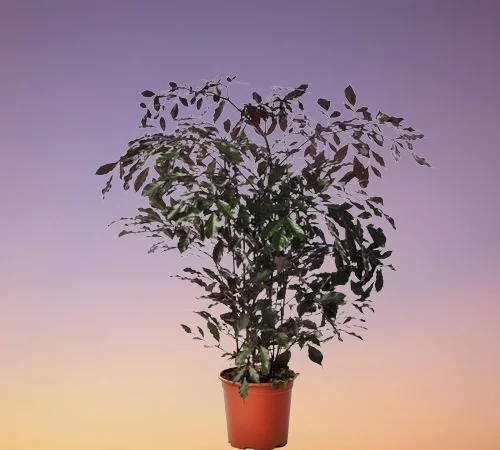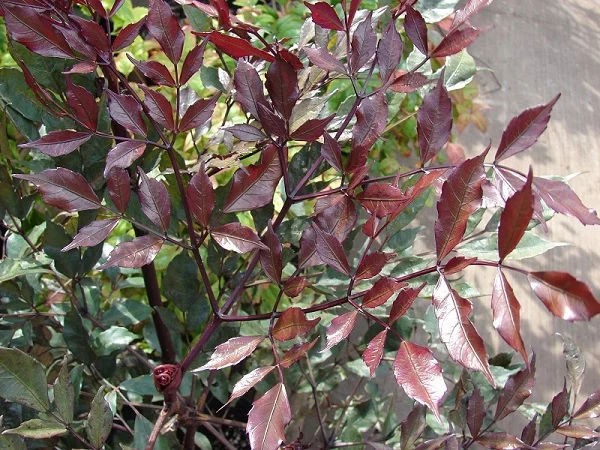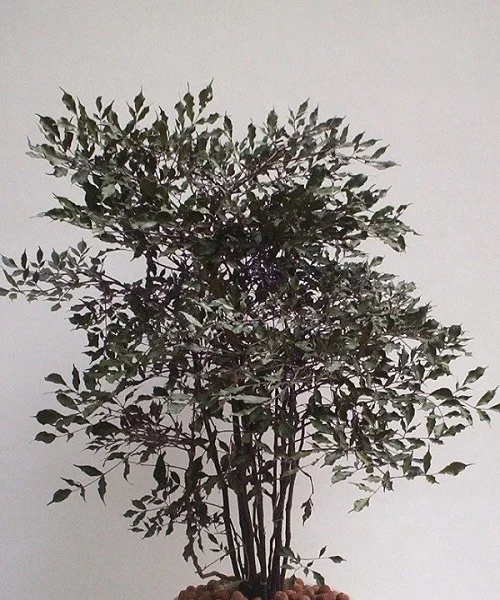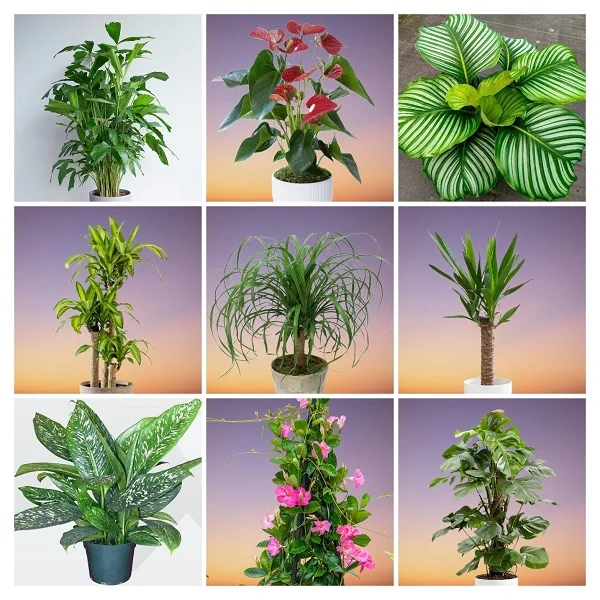Leea Burgundy (Leea coccinea) Indoor Care, Common Problems and Remedies
Some links in this post may be affiliate links
Leea coccinea (Leea Burgundy Plant) grows best in medium to bright indirect light, average warmth and humidity, and consistently moist, fertile, well-drained soil coupled with monthly feeding in the growing season.
Leea Burgundy also called Red Leea, Hawaiian Holly or West Indian Holly 'Rubra' is a rare plant but is one of the popular tree-like plants whose foliage is bronzy-red in young plants but turns green when mature.
Leea coccinea 'Rubra’ is a cultivar which features dark-red stems, bronze-red (purplish) leaves, red flowers which are pinkish inside and scarlet fruits. It is among the popular purpled-leafed plants that will add a splash of color in any space.

Botanical name: Leea coccinea
Synonym: Leea guineensis
Family: Leeaceae
Common names: Leea Burgundy, Red Leea, Hawaiian Holly, West Indian Holly 'Rubra'
Origin
Leea is a genus of plants that are distributed throughout Northern and Eastern Australia, New Guinea, South and Southeast Asia and parts of Africa.
There are about 70 species and they are placed in the Vitaceae family. But based on morphological differences, Leea plants are often placed in their family Leeaceae.
The genus was named by Linnaes after James Lee, the Scottish nurseryman based in Hammersmith, London who introduced many new plant discoveries to England at the end of the 18th century.
Size
Leea coccinea also called Leea guineensis can grow to a height of 6-8 feet and a width of about 4-5 feet. On account of its size and dislike for direct sunshine, Leea Burgundy is among the popular low-light trees for spaces with no sunlight.
Flower
The Leea flowers are attractive to wasps, bees, butterflies, flies and bettles which act as potential insect pollinators. However, it rarely blooms when grown indoors. It produces red flowers which later turn pink. The fruits are black berries.
Is Leea coccinea Burgundy toxic?
Yes. Leea coccinea Burgundy produces a milky sap which can irritate the skin. Always wear gloves when handling the plant. The plant is toxic to both humans and pets if ingested.
How to Care for Leea coccinea Indoors
To care for Leea Burgundy indoors, give it medium to bright indirect light (filtered light), warmth of 18-290C, humidity of 50-55% and consistently moist, fertile, well-drained soil coupled with monthly feeding in the growing season.
Leea coccinea care requires regular pruning to keep it neat as well as encourage a bushy growth. Repotting is needed only when it becomes pot-bound. Keep reading for more on these growing conditions and how to provide them.

Light Requirements
Leea Burgundy thrives in medium to bright indirect light; a spot infront of a large, well-lit window is perfect. Protect it from direct sunshine as it may cause the foliage to turn yellowish; you may use a light curtain to filter the sunrays.
Vey low light causes loss of leaf color. Therefore, where the natural light is not adequate, use full spectrum grow lights to supplement it.
Regularly rotate the pot to ensure that the plant receives light on all sides for uniform growth and prevent lopsided growth.
Watering
Water Leea Burgundy thoroughly in spring and summer while allowing the top 1-2 inches of soil to dry out between waterings. Maintain the soil consistently moist but not soggy to avoid yellowing and leaf drop.
Reduce watering in fall and winter to maintain the soil slightly moist as growth is reduced at this time. Do not let the soil dry out completely to prevent wilting and leaf drop.
Use water that is at room temperature to prevent cold shock which can result in stunted growth and leaf loss. Avoid chlorinated water as it can cause staining and browning of leaf edges.
Make sure that the pot has a drainage hole and the soil is free-draining to prevent waterlogging which can lead to root-rot and loss of plant.
Temperature & Humidity
Leea Burgundy flourishes in a warmth of 18-290C during the growing season. Keep it away from drafts and temperatures below 100C as they can cause reduced growth and leaf drop.
Leea coccinea has no need for extra humidity; a humidity of 50-55% is ideal for this plant. However, if the air is too dry, it may result in brown leaf tips. Therefore, to increase humidity, set the pot on a wet pebble tray or use a cool mist humidifier. Maintain good airflow to discourage fungal diseases.
Fertilizer
Feed your Leea Burgundy with a balanced, water-soluble fertilizer every 3-4 weeks in spring and summer to promote a healthy growth. Stop feeding in fall and winter as growth is minimal and feeding at this time can lead to fertilizer buildup.
Potting Mix
The best potting mix for Leea Burgundy is a fertile, well-draining soil which does not get soggy while providing the required nutrients. A blend of 2 parts of all purpose potting mix and 1 part perlite is recommended for this plant.
Repotting
The ideal time to repot a young Leea Burgundy is at the beginning of the growing season (spring to early summer). Select a pot 2 sizes larger than the current one. Use a pot with a drainage hole and free-draining soil to prevent waterlogging. Check out these self watering planters on Amazon.
Replace the top 2-3 inches of soil every 2-3 years for mature plants while taking care not to injure the roots as it can lead to disease infestations.
Pruning & Grooming
Pruning Leea Burgundy involves:
- Removal of yellow and dead leaves to keep it neat and tidy as well as discourage pests and diseases infestation.
- Pinching off the growing tips regularly to encourage a bushy, compact growth.
- Cutting back the stems of an overgrown plant at the beginning of the growing season (spring to early summer) to rejuvenate growth. Use a sharp, clean pair of pruning scissors to avoid cross-contamination.
To get rid of dust from the leaves and also discourage pest infestation, splash the foliage with plenty of water from a steady jet of water.
Leea coccinea Propagation
Leea Burgundy (Leea coccinea) propagation is easily done from stem-tip cuttings at the beginning of the growing season. Stem-tip cuttings are taken from the upper part of the plant.
Learn how to propagate Leea Burgundy Plant (Leea coccinea).

Leea coccinea Problems & Solutions
Leea Burgundy Plant (Leea coccinea) problems are yellowing and dropping leaves, stunted growth, loss of leaf color, leaf spots among others. Keep reading for more on these problems and how to fix them.
Yellowing and dropping leaves
Why are the leaves on my Leea coccinea turning yellow and dropping?
Yellowing and dropping leaves on Leea coccinea is caused by incorrect watering, soggy soil, low light, drafts, dry air or sudden change in growing conditions.
How to fix it
Incorrect watering: Water when the top 1-2 inches os soil feel dry but never allow the soil to dry out completely.
Soggy soil: Use a pot with a drainage hole and well-draining soil.
Low light: Move the plant to a brighter spot or use grow lights if the light in your home is not enough.
Drafts: Keep the plant away from sources of drafts like windy doors and windows, AC units, heat sources, stoves among others to maintain a warmth of 18-290C.
Dry air: Set the pot on a wet pebble tray or use a cool mist humidifier to step-up humidity.
Sudden change in the growing conditions: Avoid moving the plant suddenly before acclimating it to the new growing conditions.
Stunted growth
Stunted growth on Leea Burgundy is due to nutrients deficiency, temperature stress and too little light.
How to fix it
Nutrients deficiency: Feed the plant with a balanced, water-soluble fertilizer every 3-4 weeks in spring and summer but do not feed in fall and winter.
Temperature stress: Keep the plant from sources of drafts like hot air vents, heat sources, AC units among others.
Too little light: Position the plant in a brighter spot where it will receive light shade to bright indirect light or instal grow lights if the natural light is inadequate.
Loss of leaf color
Leea coccinea loss of leaf color is due to too little light. Move the plant to a brighter spot where it will receive medium to bright indirect light or instal a grow light if the natural light is not enough.
Yellow and dark leaf spots
Yellow and dark leaf spots on Leea Burgundy are due to exposure to hot direct sunlight. Move the plant to a shadier spot or use a light curtain to diffuse the sunshine.
Pests
Leea coccinea is prone to aphids, spider mites and mealybugs infestations. These sap-sucking insects are attracted to the new soft growth of the plant where they cause distorted growth.
How to fix it
- Isolate the affected plant to prevent spread to the other plants.
- Treat the plant with neem oil or an insecticidal soap as indicated by the manufacturers' on the label.
- Maintain the plant well pruned to discourage the pests.
- Set the pot on a wet pebble tray or group the plants together to elevate humidity to depress the pests infestations.
You liked it? Share on social media.
Related Content
Amazon Associates Disclosure
Homeplantsguide.com is a participant in the Amazon Services LLC Associates Program, an affiliate advertising program designed to provide a means for sites to earn advertising fees by advertising and linking to amazon.com.





